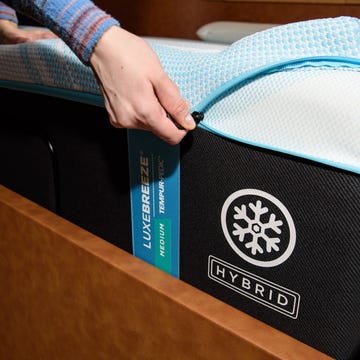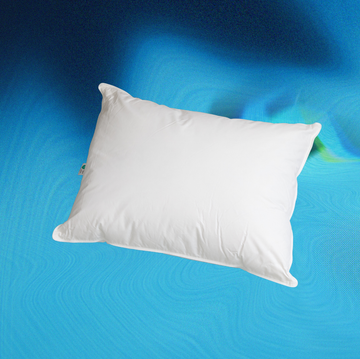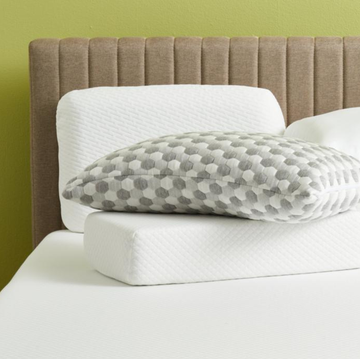When sleep isn’t coming easily, we’ll do almost anything to force ourselves into a deep slumber. Counting sheep, muscle relaxation exercises, tart cherry juice, melatonin … the list of home remedies goes on and in. But there’s a new-ish method that’s gaining traction as a simple-yet-effective way to fall asleep called the cognitive shuffle.
No, it’s not a dance, although it’s sort of a dance that happens in your mind. Intrigued? Below is everything you need to know about the cognitive shuffle to fall asleep faster, according to the expert who invented it and a clinical psychologist who specializes in sleep.
What is the cognitive shuffle?
Simply put, it’s an “imagery distraction technique” designed to calm your mind and lure you into dreamland. While in graduate school, “I would occasionally have difficulty falling asleep on Sunday nights, before the school week started,” says Luc P. Beaudoin, Ph.D., an adjunct professor at Simon Fraser University. Inspired by the visual illusion theories of Claude Lamontagne, Beaudoin set out to “develop a cognitive technique that would trick the brain into falling asleep.”
Cognitive shuffling prompts you to visualize a variety of different, unrelated things. This process does two important things. First, it “keeps one's mind off the kind of thinking that might keep you awake such as worrying, ruminating and problem-solving — or even something exciting like thinking about the object of one's infatuation,” says Beaudoin. It’s also “meant to put the brain in a state that is similar in some ways to natural sleep onset, and hence to trick the brain into transitioning to sleep.”
How do you engage in cognitive shuffling?
When you’re lying in bed, ready to go to sleep, try the following DIY cognitive shuffle technique or download the mySleepButton that Beaudoin created which prompts users with curated words and phrases.
- Think of a neutral word that contains at least 5 letters, such as BEDTIME. Try to pick a word with a variety of different letters, rather than one with repeating letters (like BANANA).
- Take the first letter of the word and come up with another word that starts with that letter. Then, visualize what that new word represents. For instance, for the letter B, you might think of ball and then picture yourself kicking a soccer ball. After visualizing for a few moments, move on to another word that starts with B and imagine that as well. Perhaps the word blanket might make you think of cuddling your favorite throw. Pro tip: Visualizations are more effective if they include an action and/or senses rather than a static object (such as playing a piano instead of looking at a piano).
- When you’re bored with the first letter (in this case, B) or can’t think of any more words that start with it, start visualizing things that begin with the second letter. With the letter E, the word egg might come to mind, and you can imagine yourself cooking eggs.
- If you make it through your initial word (BEDTIME in this instance) and you’re still awake, start over with a new word.
How does cognitive shuffling help with sleep?
The first theory is that when you imagine a series of things (especially visualizations of yourself doing activities), it requires a chunk of “neural bandwidth” so there’s less bandwidth available for worrying and ruminating. Essentially, it gives your brain something else to do instead of focusing on thoughts or emotions that might be keeping you awake.
The second theory is related to the randomness of the cognitive shuffle. “The idea is that when we are thinking and feeling in a structured way with meaningfully related things, our brain and stress system is ‘awake,’” explains Michael Goldstein Ph.D., a clinical psychologist with Cambridge Psychology Group and lecturer on psychology at Harvard Medical School who specializes in sleep and circadian rhythms. “When our minds wander in unstructured or more meaningless ways, our brain and stress system is in a mode more similar to sleep. So, cognitive shuffling is a way to practice or rehearse the brain patterns of sleep, paving the way for it to happen more smoothly.”
Keep in mind that Beaudoin published his first paper that described this technique in 2013, which wasn’t that long ago, especially when you consider cognitive behavioral therapy (CBT, the gold standard treatment for chronic insomnia) was developed in the 1960s. “There's not much experimental data specifically on the cognitive shuffle yet,” says Beaudoin. “Insomnia specialists and I are planning further empirical studies on it this fall.”
Is there anyone who shouldn’t try the cognitive shuffle?
“There's a difference between mere in somnolence (difficulty falling asleep) and insomnia (which is a clinical, DSM, psychiatric condition),” says Beaudoin. “The technique is only meant to help people who are having difficulty sleeping due to insomnolent processes (worries, etc.).” People with chronic insomnia should reach out to a sleep specialist, who may recommend an evidence-based treatment like CBT.
Goldstein agrees. “It may not be effective, or might even backfire, for people with certain types of obsessive thinking styles for whom this technique may ironically just give more material to be mentally stuck on,” he says. “For those individuals, body-based relaxation practices such as progressive muscle relaxation, gentle stretching or breathing practices might be more helpful.”
The bottom line
“Cognitive shuffling is a technique that can be used to counteract the sticky thoughts and emotions, like ruminating about what went wrong today or worrying about might happen tomorrow, that sometimes plague our minds when we’re trying to fall asleep and end up keeping us awake,” says Goldstein. “Instead of staying stuck on a cohesive string of thoughts and emotions, you shuffle things up by purposefully thinking more randomly.” Of course, our sleep can be affected by many things including the temperature of the room, nearby noises, the food we eat, how often and when we exercise, our wind-down routine, life stressors and much more. The cognitive shuffle is just one piece of a complex puzzle, so if you’re regularly struggling with insomnia, it’s smart to consult with a sleep specialist.













